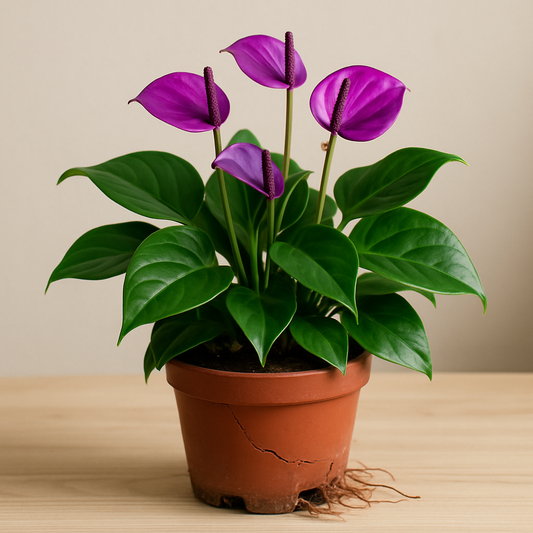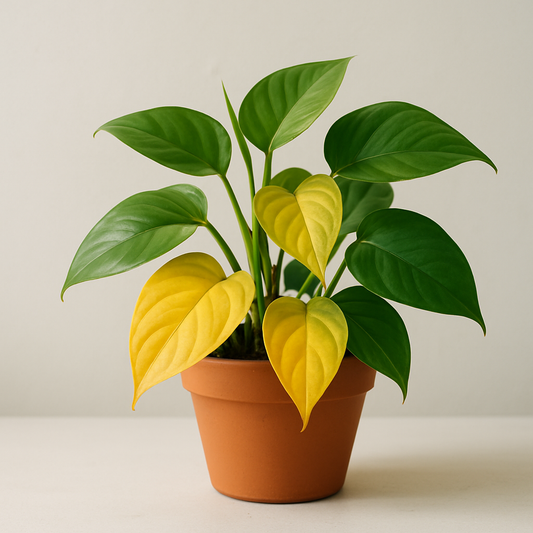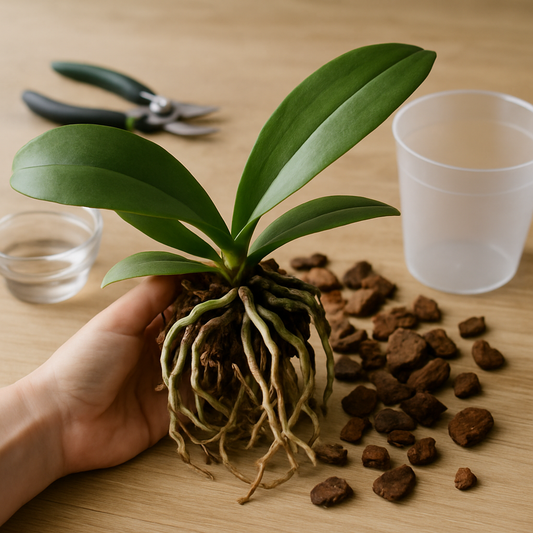If you've noticed your pothos leaves turning yellow, you're not alone. Pothos, a beloved and low-maintenance houseplant cherished for its lush, vibrant green foliage, often signals distress through yellowing leaves. This common issue can stem from a variety of underlying problems, but don't worry—identifying the cause is the first step to restoring your plant's health. In this guide, we'll explore the primary reasons for yellowing leaves, including overwatering, improper lighting, root rot, environmental stress, fertilizer issues, and even natural aging. With a proper diagnosis and tailored care, you can revive your pothos and keep it thriving. Let’s dive into solving the mystery of why are my pothos leaves yellow.
Overwatering: The Most Common Culprit
One of the leading reasons for pothos leaves turning yellow is overwatering. This issue arises from an imbalance in soil moisture, where the plant receives more water than it can handle. According to Bloomscape, overwatering is a frequent cause of distress in pothos plants. When excess water lingers in the soil, the roots are deprived of essential oxygen, leading to yellowing leaves that may also wilt or develop unsightly brown spots (source).
So, how can you tell if overwatering pothos is the problem? Look for these telltale signs:
- Yellowing leaves accompanied by wilting.
- Brown spots appearing on the yellowed areas.
- Soil that feels consistently soggy or wet to the touch (source).
Fortunately, fixing an overwatered pothos is manageable with a few adjustments. First, only water your plant when the top 25% of the soil feels dry. Ensure the soil remains damp but never soggy. Remove any yellow leaves, as they won’t regain their green color. Lastly, improve drainage by using a pot with drainage holes or adding materials like perlite to the soil mix to prevent waterlogged roots (source).
Lighting Issues: Finding the Right Balance
Improper lighting is another common reason for pothos yellow leaves lighting issues. Pothos plants thrive in bright, indirect light, and deviations from this ideal can lead to stress. Direct sunlight can scorch the delicate leaves, causing them to turn yellow, while insufficient light may stunt growth and contribute to fading color (source, source).
To meet pothos light requirements, position your plant near a window with filtered light—a sheer curtain can work wonders to diffuse harsh rays. Avoid placing it in direct sunlight, which can burn the leaves, and ensure it’s not tucked away in a completely dark corner where it can’t photosynthesize effectively. Striking the right balance will help maintain vibrant green foliage and prevent yellowing (source).
Root Rot: A Hidden Threat
Yellowing leaves can also signal pothos root rot yellow leaves, a serious condition often linked to overwatering and poor drainage. Root rot occurs when the soil remains overly saturated, causing the roots to become dark, mushy, and unable to function properly. This deprives the plant of nutrients and water, leading to yellow leaves as a visible symptom (source).
To fix pothos root rot, start by inspecting the roots—gently remove the plant from its pot and check for dark, soft, or mushy areas. Trim away the affected roots with clean, sterilized scissors to prevent further decay. Repot the plant in fresh, well-draining soil, and adjust your watering schedule to prevent future saturation. Pots with drainage holes and a lighter soil mix can make a big difference in preventing recurrence (source).
Environmental Stressors: External Factors to Watch
Beyond watering and lighting, various environmental factors can contribute to pothos environmental stress and result in yellowing leaves. Understanding why are my pothos leaves turning yellow often requires evaluating the plant’s surroundings. Let’s break down some key external stressors that might be affecting your pothos and explore ways to mitigate their impact.
Temperature Fluctuations
Sudden changes in temperature or exposure to drafts from vents, air conditioners, or windows can stress your pothos, leading to damaged, yellowing leaves. Consistent temperatures are key to keeping your plant happy. Aim to maintain an environment between 65-85°F, and keep your pothos away from areas prone to temperature swings (source).
Relocation or Repotting Stress
Have you recently moved or repotted your pothos? Such changes can temporarily stress the plant, causing yellow leaves as it adjusts to a new environment or pot. To minimize disruption, handle these transitions with care and give your pothos time to acclimate. Avoid frequent relocations, and ensure the new pot and soil conditions are suitable (source).
Soil Toxicity and Ethylene Damage
Less common but still significant, soil toxicity—such as manganese toxicity from overuse of certain fertilizers—can cause yellowing, particularly in older pothos plants. Additionally, ethylene damage from fungicides or decaying plant matter, especially in cooler weather, can harm foliage. To prevent these issues, use balanced fertilizers sparingly and keep the area around your pothos free of rotting material (source).
Fertilizer Problems: Too Much or Too Little
Nutrient imbalances can also lead to pothos fertilizer yellow leaves. Over-fertilization disrupts soil health by causing a buildup of salts, which can burn roots and result in yellowing leaves. Conversely, under-fertilization may cause pothos nutrient deficiency, leaving the plant lacking essential nutrients for healthy growth (source).
To avoid these issues, follow the recommended fertilizer schedule for pothos—typically a balanced, water-soluble fertilizer applied monthly during the growing season. Dilute the fertilizer to half the recommended strength to prevent overfeeding, and monitor how your plant responds to adjust as needed. A little goes a long way in maintaining vibrant foliage (source).
Natural Aging: When Yellowing Is Normal
Not all yellowing is a cause for alarm. Pothos natural yellowing occurs as part of the plant’s aging process, where older leaves at the base turn yellow and eventually die off. This is a normal occurrence as the plant redirects energy to support new growth at the top (source).
If only a few lower pothos aging leaves are yellowing and there are no other symptoms like wilting or widespread discoloration, there’s likely no need to worry. Simply prune these old leaves to keep your plant looking tidy and encourage healthy new growth. However, if the yellowing spreads or pairs with other issues, it’s time to investigate further.
How to Diagnose and Revive Your Pothos
Ready to fix yellow pothos leaves and revive pothos yellow leaves? Diagnosing the issue requires a systematic approach to pinpoint the root cause. Follow these steps to assess your plant’s condition and implement the right solutions:
- Check soil moisture: Is the soil too wet or bone dry? Adjust watering based on the top 25% dryness rule.
- Inspect lighting: Ensure your pothos receives bright, indirect light without direct sun exposure.
- Examine roots: Look for signs of root rot by checking for mushy, dark roots, and repot if necessary.
- Assess the environment: Stabilize temperature, minimize drafts, and avoid frequent relocations.
- Evaluate fertilizer use: Stick to a balanced feeding schedule and avoid over-fertilizing.
Once you’ve addressed the specific issue, be patient—recovery can take time. Monitor your pothos closely and adjust care as needed. With consistent attention, most plants bounce back to their lush, green glory.
Restoring Your Pothos to Vibrant Health
Yellowing pothos leaves turning yellow can be concerning, but as we’ve explored, the causes—ranging from overwatering and lighting issues to root rot, environmental stress, fertilizer imbalances, and natural aging—are often manageable with targeted care. The key is to diagnose the problem accurately and adjust your pothos plant care routine accordingly. With a little patience and attention, most pothos plants can be revived to their vibrant state. Keep a close eye on your plant, tweak care practices as needed, and don’t hesitate to share your experiences or ask questions in the comments below. Let’s help each other grow thriving, beautiful pothos!




